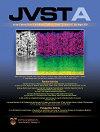Effects of C4F8 plasma polymerization film on etching profiles in the Bosch process
IF 2.1
3区 材料科学
Q3 MATERIALS SCIENCE, COATINGS & FILMS
引用次数: 0
Abstract
The Bosch process is a deep etching method for silicon that uses C4F8 plasma-deposited polymerized films as passivation films to protect the silicon sidewalls. This study measured the deposition rate of the passivation films and the etch rate with F-radical exposure and analyzed the chemical composition of the films. Additionally, we observed the deformation of the passivation films during the Bosch process and assessed its influence on the etch profiles. As the C4F8 flow rates increased, the deposition rates attained a local maximum, subsequently decreased to a local minimum and then increased again. The deposition rates were extremely low when the pressure exceeded 10 Pa. With the increasing C4F8 flow rates, inductively coupled plasma power, and pressure, the respective bond content varied up to 10%, and C—CFX and C—C bond contents were replaced with CF2 and CF contents, respectively. The results indicated that the chemical composition of the films did not affect the etch rates of the films, and upon exposure to F radicals, the chemical composition of all films transformed into an identical chemical composition with a higher CF2 bond content. Polymerized films with low CF2-bond content deformed with F-radical exposure, enabled the passage of F radicals, and did not serve as passivation films. In addition to high deposition rates and high F-radical resistance, the Bosch process requires passivation films with high CF2 bond content. The present findings will aid in tuning the parameters of the Bosch process and increase the productivity of silicon deep reactive-ion etching.C4F8等离子体聚合膜对Bosch工艺蚀刻剖面的影响
博世工艺是一种硅的深度蚀刻方法,使用C4F8等离子沉积的聚合膜作为钝化膜来保护硅侧壁。本研究测量了钝化膜的沉积速率和f自由基照射下的蚀刻速率,并分析了钝化膜的化学成分。此外,我们观察了在博世过程中钝化膜的变形,并评估了其对蚀刻轮廓的影响。随着C4F8流速的增加,沉积速率达到局部最大值,随后降低到局部最小值,然后再次增加。当压力超过10 Pa时,沉积速率极低。随着C4F8流量、电感耦合等离子体功率和压力的增加,其键含量变化最大可达10%,C-CFX和C-C键含量分别被CF2和CF含量所取代。结果表明,膜的化学成分对膜的蚀刻速率没有影响,并且在F自由基作用下,所有膜的化学成分都转变为相同的化学成分,并且CF2键含量更高。低cf2键含量的聚合膜在F自由基暴露下发生变形,使F自由基得以通过,不能作为钝化膜。除了高沉积速率和高f自由基抗性外,博世工艺还要求钝化膜具有高CF2键含量。目前的研究结果将有助于调整博世工艺的参数,提高硅深反应蚀刻的生产率。
本文章由计算机程序翻译,如有差异,请以英文原文为准。
求助全文
约1分钟内获得全文
求助全文
来源期刊

Journal of Vacuum Science & Technology A
工程技术-材料科学:膜
CiteScore
5.10
自引率
10.30%
发文量
247
审稿时长
2.1 months
期刊介绍:
Journal of Vacuum Science & Technology A publishes reports of original research, letters, and review articles that focus on fundamental scientific understanding of interfaces, surfaces, plasmas and thin films and on using this understanding to advance the state-of-the-art in various technological applications.
 求助内容:
求助内容: 应助结果提醒方式:
应助结果提醒方式:


